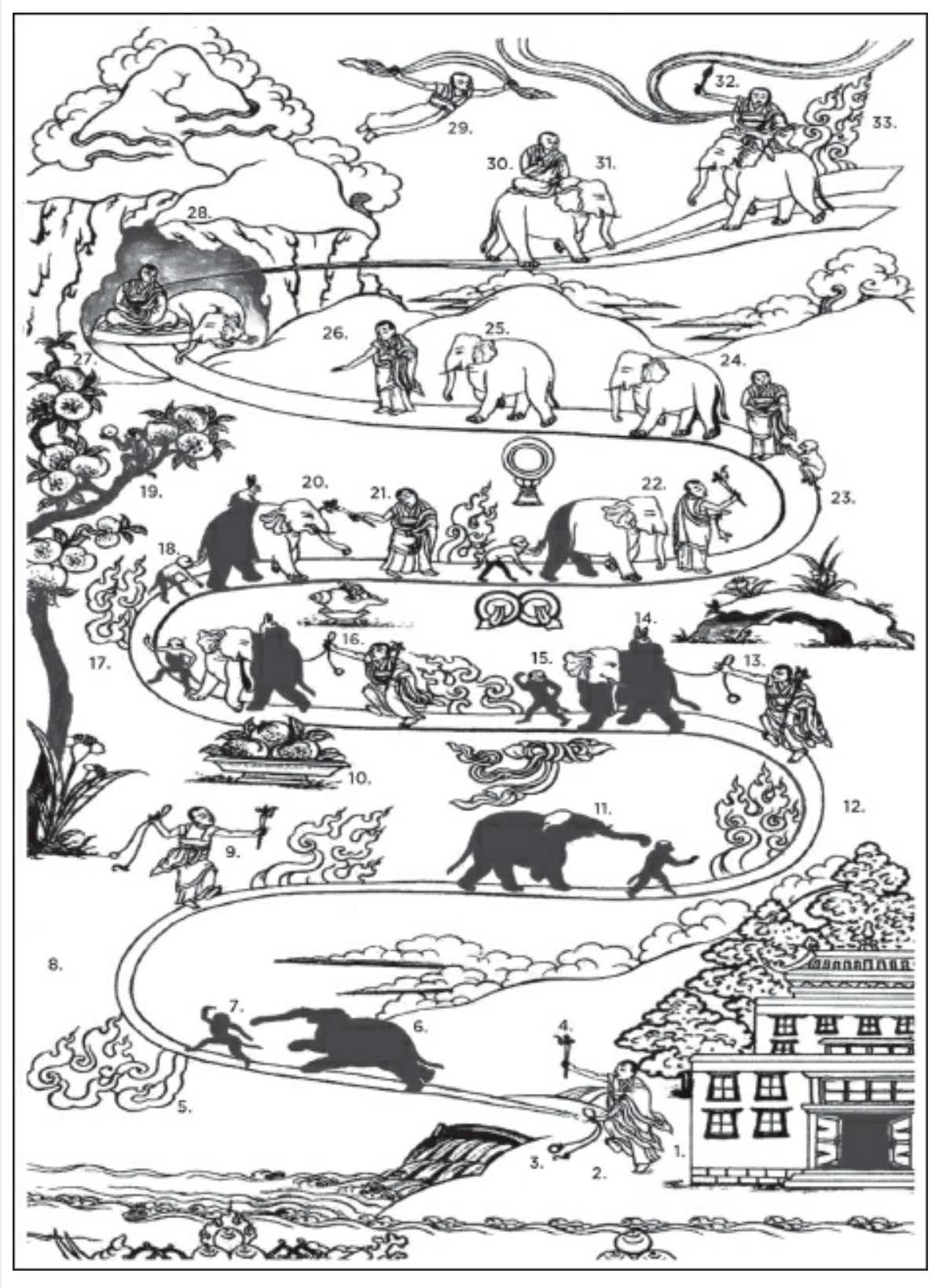Differing Perspectives, Compassion in the Buddhist and Christian Traditions
by Alexander Norman
If the Dalai Lama is known for anything above all, it is for his advocacy of compassion.¹ And if his digital following is anything to go by (around 19.3 million Twitter followers at the time of writing – fully half a million more than Pope Francis), this advocacy appeals strongly to huge numbers of people. What, for many, makes it especially attractive is the Dalai Lama’s insistence that compassion is not dependent on whether the individual is an adherent of one particular faith tradition or another, or that it is contingent on professing one at all. For the Dalai Lama, compassion is beyond religion (the title of one of his many books).
The Dalai Lama’s claim that compassion is a universal good seems beyond dispute. It is central to the Hindu / Brahminic tradition where it is a condition of ahimsa, the principle of non-violence. Within Islam, compassion is cited as one of the chief characteristics of Allah. For Jews and Christians too, compassion is a resonant word. It is used to describe God multiple times in, for example, the book of Psalms. Among the gospels, St Matthew speaks often of Jesus’ compassion.²
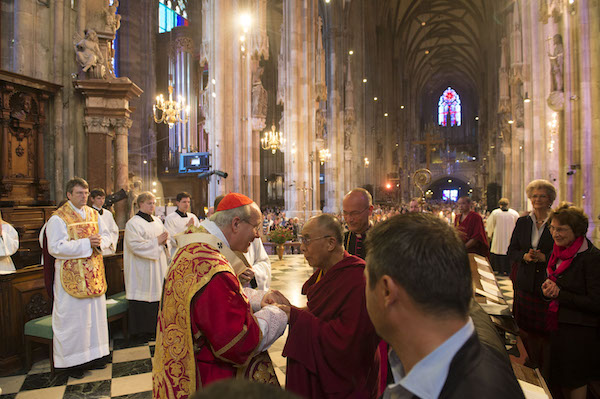
His Holiness the Dalai Lama in Vienna | 25-27 May 2012 | © 2005 Manuel Bauer
Here, though, we must sound a word of caution. When we see the word compassion in the Bible and when we hear it from the Dalai Lama, it is important to recognise that it is being used in slightly different ways. In both cases, it is a translation from different languages and cultures.
Although the English word ‘compassion’ derives directly from the Latin compassionem (literally, suffering with), it is used more generally to translate the term misericordia. This the word used in the Vulgate (Latin) bible to render the Greek splagchnizomai, literally to feel something in one’s guts. Similarly, it is misericordia that, for example, St Thomas Aquinas uses in his discussion of ‘compassion’ in three different contexts in his great theological treatise, the Summa Theologica. In the first instance, he uses it in a discussion of God and divine omnipotence³; in the second, with respect to charity⁴ and, in the third instance in his discussion about the moral character of the emotions.⁵
In contrast, the fourteenth century Tibetan sage Je Tsongkhapa, whom the Dalai Lama regards as one of the foremost authorities within the Tibetan Buddhist tradition, uses the compound snyng rje to translate the Sanskrit and Pali term karuna, both terms generally given as ‘compassion’ in English. In the Buddhist tradition generally, karuna is identified with a mental state that is both a condition of happiness in the present life and a cause of heavenly rebirth in the next. The term karuna itself derives from the word kara, to do or to act, and is related to the term karma, an act, or an action. The one who exercises karuna is one who acts is a way that tends towards the overcoming of suffering: its ‘far enemy’, or antonym, being cruelty.
Prima facie, the association of the Tibetan term for ‘compassion’ with action stands at odds with the Graeco-Roman association of ‘compassion’ with emotion. In the Indo-Tibetan tradition, ‘compassion’ is, however, also closely associated with the emotion described as ‘loving-kindness’ (Sanskrit metta) while Aquinas’ construal of compassion as a passio animae, an affective reaction which brings about a change in bodily state, is seen by him as the basis, when joined with reason, of its correlative virtue, caritas. Arguably, therefore, the meanings of snying rje and misericordia, both of them translated as ‘compassion’, are not so far apart as they might seem at first.
It is nonetheless important to recognise that when Tsongkhapa talks about compassion and when Aquinas talks about compassion, they are not talking about quite the same thing. By extension, when the Dalai Lama talks about compassion and when the Holy Father talks about compassion, they are not talking about quite the same thing either.
But does this matter? If compassion in the sense that the Dalai Lama uses it is unambiguously a good thing, and if compassion in the sense that the Pope uses it is also unambiguously a good thing, why quibble? After all, the Dalai Lama has often remarked how many of the practices of Tibetan⁶ Buddhism and the Catholic church are similar. He has even suggested that there could well have been early contact between the two traditions. That Tibetan Buddhists and Christians came into contact early on is, in fact, well attested. The 7th century Patriarch Timothy, writing to his friend Severus, mentions that he is preparing to anoint a metropolitan for ‘the land of the Tibetans’⁷. Given that a metropolitan is a bishop who exercises not merely diocesan but provincial powers, it is clear that this community must have been a reasonably important one.⁸ And while we don’t know what became of this early Tibetan mission of the Christian church, we do have some further evidence of it in the form of crosses erected in Ladakh and from the fact that a number of Christian scriptures turned up in the great library at Dunhuang, walled up in the eleventh century (and rediscovered early in the twentieth). We know, too, that the ‘Silk Road’ trading routes linking China and Rome played an important role in the dissemination of religious ideas as Greek, Jewish, Christian, Manichaean, and Islamic cultures were carried across Central Asia and into China while, heading in the opposite direction, we have evidence of Buddhist culture spreading as far west as Iran.
A remarkable – and charming – example of this early contact between the Christian and Buddhist traditions comes in the Georgian Balavariani (first written down in the tenth century, but drawing on a tradition that has been dated back at least as far as the eighth century), the story of Barlaam and Josaphat. This tells of a King who imprisoned his son in order to protect him from the world. Whereas in the Buddhist tradition, the prince escapes and, after various spiritual adventures (including a period as an ascetic) attains Enlightenment under a banyan tree, in the western version of the story, the Prince meets with one Barlaam and is converted to Christianity. The two men are subsequently attested as saints and accorded their own feast day in the Roman calendar.

St. John The Devine | New York City | New York | USA | 20.09.2003 | © 2005 Manuel Bauer
Outwardly still more striking, however, is the long list of similarities in the practices of Tibetan Buddhists and Catholics. From vowed communities of celibates to divisions between cenobite and eremite (those who live in community and those who live as hermits), to the high value placed on book learning and scholastic training, to the use of beads and the veneration of saints and their relics; from the elaborate liturgical calendars marked by equally elaborate and minutely regulated vestments to the employment of ritual gesture in ceremony and the practise of sacramanental eating and drinking; from the centrality of icons and sacred artefacts to chant and the use of litanies in conventual prayer; from the lectio divina of both ordained and lay people to the importance of pilgrimage to places of spiritual and historical significance – the parallels are numerous and not to be found in such profusion in any other two such culturally disparate traditions. So much is this so that many make the mistake of seeing the Dalai Lama as a sort of Buddhist Pope. This is a serious misunderstanding. In fact, the Dalai Lama is neither the leader nor the head of his own dgelugs tradition, nor does he have jurisdiction over any other lama or monk. Unlike the Pope who appoints and, in principle, has direct authority over every Bishop of the Catholic church, the power of the Dalai Lama over other monastics is moral rather than juridical.⁹ He is not even head of the monastery to which he belongs.
Nevertheless, when we come to think of outward dissimilarities, it is quite hard to find them. Within the Tibetan tradition, disputation as a means of sharpening the minds – and the arguments – of young novices is a remarkable feature of the monastic educational curriculum. Yet, although it has completely died out in Catholic circles, within living memory, disputationes (conducted in Latin) were a feature of most Catholic seminaries in the years prior to the Second Vatican Council. Similarly, while in addition to the Dalai Lama, a significant number of other lamas¹⁰ enjoy the sort of status only accorded to stars of screen, stage and sport in most parts of the world, St Ambrose was by no means the last bishop to be raised to his throne by public acclamation. We read in the Church Fathers of others who were compelled to take office simply on the grounds of enthusiastic public approbation. Likewise, mass public gatherings to listen to discourses given by popular religious teachers is practically unknown in Catholic circles today – excepting only rare and, typically, brief papal addresses – even if they do continue to be a feature of the Evangelical movement. Popular gatherings of this sort are still a frequent occurrence among Tibetan Buddhist communities, however.
Apart from the obvious difference that the chief object of the Buddhist’s devotion is to the person of the Buddha whereas that of the Catholic is to the person of Christ, it is not until one delves into the belief systems that these outward practices and liturgies support that the philosophical and theological differences start to become apparent. And yet, as the Dalai Lama often says, these differences are the very thing that tend to drive us apart from one another. Much better, he argues, to focus on the similarities. From the Buddhist perspective, he is entirely correct to do so. Since, for most people, Enlightenment / Awakening entails steady effort over countless lifetimes, the implications of these differences can be postponed until the individual has attained the spiritual maturity to deal with them in the right way. For the Christian, however, this is not the case. It is essential that the correct choice is made precisely now - ‘for the kingdom of God is at hand’.¹¹
Persuasively, however, the Dalai Lama points out that we human beings are all the same. We all want to to be happy and not to suffer. No one goes out of their way to be miserable – except, perhaps in pursuit of a particular goal (the object of which is happiness). And in this sameness, we all share not only the disposition to appreciate the compassion and the kindness of others, but also the ability to be kind and compassionate to others. It is, he says, simply part of human nature. In contrast, the impulse to violence and aggression, while also innate, is not, he argues, foundational. A baby smiles before it lashes out. The child thrives on its mother’s affection whereas if neglected or abused, its physical and mental development will suffer. Similarly, the first instinct of one child on meeting another is, almost invariably, to play, not to fight. Even from just considering the human body, the Dalai Lama says, we can see that it is made in such a way that expressing affection is easier and more pleasurable and rewarding than expressing aggression. You have to make a fist before you throw a punch while all that we require to give or to receive affection is that we open our arms to embrace the other.
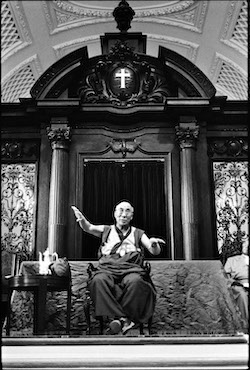
Memorial Church | Harvard | Massachusetts | USA | 15.09.2003
© 2005 Manuel Bauer
Taking these observations as his starting point, the Dalai Lama goes on to argue that we will only be truly happy when we do two things. Firstly, we need to curb our afflictive emotions and, second, we need to act compassionately. According to him, this is the sure path to inner peace which in turn, is the foundation of genuine happiness.
So far as compassion itself is concerned, for the Dalai Lama, this is a matter of responding with generosity to others’ suffering. The empathy we have for the one who suffers is precisely the thing that, to a greater or lesser extent, all sentient beings share. Our aim should thus be to develop these natural feelings of empathy to the point where we feel compelled to act on them. Compassion itself is not merely a feeling, however. According to the Dalai Lama (following Tsongkhapa), there is a mental component as well. It entails not just emotion but also thought – thought which can be modified through deliberately training the mind. The Dalai Lama explains that, in the first instance, this is done by learning to control our anger: the impulse, however subtle, behind every act of violence, no matter how minor. This, he says, becomes very much easier when we understand properly the oneness of humanity, a humanity united in the shared characteristics of desiring happiness for ourselves and of ourselves not wanting to suffer. When, by contrast, we focus on what divides us, all too easily we lose sight of the fact that those with whom we disagree are exactly the same as us in wanting to be happy and to avoid suffering.
As a means to bringing about the calm mind that is the basis for compassion, the Dalai Lama argues, there is no better way than through meditation. This, he tells us, is a skill that can be learned by anyone through practise. Being a practitioner of some other religion than Buddhism (and it should be noted that, for Buddhists, religion is always a matter of practice, or yoga – the core meaning of which is discipline) need not be an impediment to acquiring this skill. Again, one does not need to practise any religion at all in order to be a successful meditator. For those non-Buddhists who want to meditate, the Dalai Lama suggests ways in which it might be practised – for example, by Christians, using the image of a cross in visualisation exercises.
Now the Tibetan word for meditation, gom, means, literally, familiarisation. The idea is that through meditation, we familiarise ourselves with different states of mind. We learn, among other things, to recognise that state of mind which accompanies the compassionate action. Having done so, we learn to generate this mind state as an antidote to our habitual self-centred attitude. The goal is, eventually, to attain complete mastery over our mental faculties, a goal which, it is assumed, will take many lifetimes to achieve but towards which a dedicated practitioner can make substantial progress in a matter of years. A famous illustration depicts the mind as a wild elephant, the meditator as a mahout whose business it is to subdue the animal. This training is effected in thirty-three carefully programmed stages. To begin with, the elephant runs away from the mahout. But with persistence and gentleness, the beast is brought to the point where it will accept a rope. Trust is built up and the elephant begins to do its tamer’s bidding until eventually it no longer needs the rope. First it follows the mahout, then it allows itself to be mounted. Finally, at the thirty third stage, the mahout and the elephant become friends and the animal does whatever it is bidden.
It is perhaps not surprising that, given contemporary society’s short attention span, the Dalai Lama’s message of compassion is given greater prominence than his advocacy of meditation. Nonetheless, the enormous popularity of mindfulness suggests that many appreciate the value of meditation too – even if mindfulness itself can be characterised as an attenuated form of meditation. It is a first step on the way. As the Dalai Lama is quick to point out, however, meditation as practiced within the Tibetan tradition invariably combines mindfulness with other techniques. These other techniques are designed, among other things, to increase the practitioner’s ability to concentrate single-pointedly – and with the mind fully alert – on a chosen object (whether that object be a physical object or a concept) for long periods of time. It is held that being able to focus undistractedly for a period of at least two hours is a sign of proficiency. This kind of proficiency may seem at a far remove from the practise of compassion and, to see how they are connected, it is helpful to consider the fundamental insight expressed by the Buddha in the Four Noble Truths. These are encapsulated in the following formula:
- The truth of suffering
- The truth of the cause of suffering
- The truth of the cessation of suffering
- The truth of the Path to the cessation of suffering
From the Buddhist perspective, to be in the world is to suffer. The cause of our suffering is our past deeds (ie our karma accumulated over the course of countless lifetimes: it is important to acknowledge here the Buddhist commitment to the doctrine of rebirth). It is also important to recognise the wide range of the word ‘suffering’ (in Sanskrit, duhkha). It is includes not only the gross physical suffering we experience when, eg we are in pain with a headache but also connotes our experience of the general unsatisfactoriness of existence. When we are thirsty, we drink and this gives us temporary satisfaction. But if we continue to drink, soon enough we will start to suffer once more: no sooner do we overcome one kind of suffering than we are confronted with another. The good news (we could call it the gospel of Buddhism) is that it is possible to attain to a state of being without suffering (the third Noble Truth). The way to do this is to follow the Path set out by the Buddha – the acme of which is the meditative path that combines mindfulness with concentration (the fourth Noble Truth).
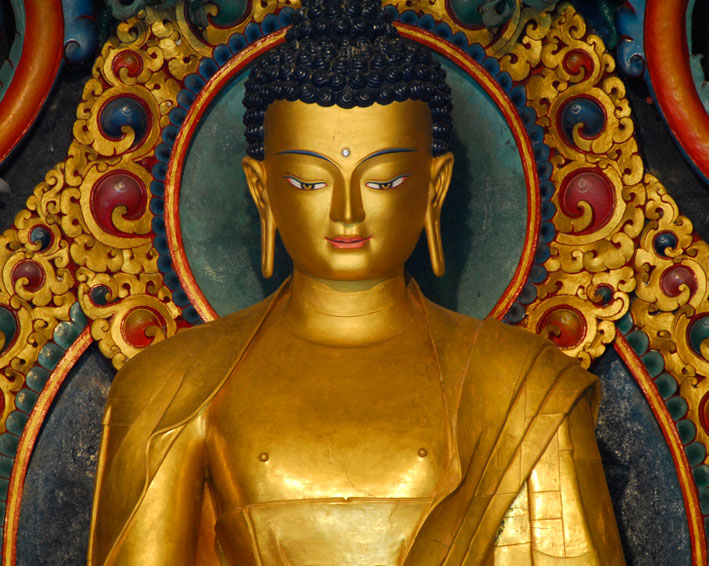
Golden Buddha statue in Bodhgaya | 2007 | Bodhgaya, India | © Paul O'Connor
A vital point to understand here is that, on the Buddhist view, there is one – and only one – way to attain enlightenment and that is by following the Path elaborated by the Buddha. This Path is classically summarised in the Noble Eightfold Path which calls on the practitioner to espouse ‘Right view’; maintain ‘Right resolve’; express themselves in ‘Right speech’; conduct themselves with ‘Right action’; maintain themselves with ‘Right livelihood’; commit themselves to the Path with ‘Right effort’; establish themselves with ‘Right mindfulness’ and, finally, to maintain ‘Right concentration’.
It would require a great many words to explain in adequate detail what is meant by each of these injunctions. For our purposes here, however, it is enough to note the importance of meditation (covered in the seventh and eighth injunctions): there can be no Enlightenment (or perhaps, more accurately, no Awakening) without proper training of the mind by means of meditation which, although it certainly can be practised by lay people, is raised to a way of life within the Buddhist monastic tradition.¹²
From its earliest beginnings, Buddhism has been a religion of renunciation. The Buddha himself gave up the world and only re-entered it – to teach – having attained Enlightenment. Following his earthly death, or parinirvana, the Buddha’s earliest disciples were forest-dwellers: people who withdrew from the world in order to follow the Way. Gradually, however, the modern sangha, the monastic community which became the primary vehicle for the preservation and dissemination of the Buddha’s teaching, came into being.¹³ Among other things, joining the sangha enabled individuals to renounce the world and yet be supported in their basic needs as they sought to progress along the Buddha’s path to Enlightenment.
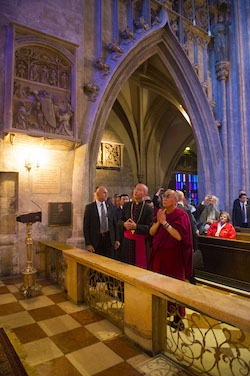
His Holiness the Dalai Lama in Vienna, 25-27 May 2012
© 2005 Manuel Bauer
Here again we see striking similarities in the way both Christians and Buddhists have sought to deepen their religious faith and practise. Just as within the Tibetan Buddhist tradition there are Christian monks and nuns who renounce the world to dedicate themselves to lives of solitary prayer (in the case of Tibetan Buddhist renunciates, some actually have themselves bricked up inside their cells, receiving food and water through a screened aperture and do not leave them alive). Both do so with similar motives – the Christian to offer themselves to God for the salvation of souls, the Buddhist to perfect their minds in order to attain Buddhahood for the benefit of others. Again, though, the activities are not precisely identical. For example, it is interesting to note that Buddhist monasteries do not have the explicit tradition of hospitality of their Christian counterparts and, indeed, the injunction of Jesus to feed the hungry, give drink to the thirsty, clothe the naked, visit the sick and those in prison is not central to the Buddhist tradition generally¹⁴.
From the perspective of the Buddhist tradition, however, training one’s mind is itself an act of compassion. This is hugely important. Within the Mahayana tradition espoused by the Dalai Lama, the individual who meditates does so not for their own benefit but rather with the aspiration to facilitate the enlightenment of all other sentient beings. And it is this, above all, that is what compassion (snying rje) consists in. The cornerstone of this feature of the Mahayana tradition is the bodhisattva vow, whereby the individual practitioner dedicates themselves to ‘generate the mind of Enlightenment / Awakening for the sake of all beings’.¹⁵ Progress along the Path by means of mind training is important both for oneself and for others because the more the individual overcomes both the afflictive emotions and the attachment (or grasping at the notion of self) that underlies these and which enmeshes them in samsara, the better they are equipped to teach the dharma to others. This is important because teaching the means to liberation is itself a necessary condition thereof: this is what is meant by the conduct prescribed in the Noble Eightfold Path. So if it seems, at first sight surprising that the ‘corporal works of mercy’ of the Church are not central to the Buddhist monastic tradition, it is important to understand that, from the Buddhist perspective, no matter how many good works a person undertakes, and no matter how firm their faith – let alone whether they are in a state of grace at the moment of death – the inevitable consequence is a return to samsara. This is not simply because of unexpiated sin, as the Christian might suppose, but because where there is still attachment, there is no possibility of liberation from samsara.
We find, too, that in contrast to Buddhist meditation, Christian prayer is overwhelmingly concerned firstly with praise and, secondly with petition. It can thus be described as dialogical in character – insofar as when the Christian offers praise, it is praise to the persons of the Holy Trinity: typically, it is praise offered to the Father, through the Son, by means of the Holy Spirit. Buddhist meditation can be characterised as essentially monological in character. The blessings of the Buddhas and other great beings are sought as a preliminary to practise. The practise itself is offered to the Buddhas and for the benefit of all sentient beings, but the work of mindfulness and attention is directed by the practitioner at his or her own mind. The aim, in the first instance is, as we have seen, to bring the mind under control. The ultimate aim, however, is to undercut and (by doing so) to eliminate the arising of afflictive emotion.
What are these afflictive emotions? They are very similar to the passions described by classical Christian writers, notably St Thomas Aquinas, and include anger, envy, greed, pride and fear. The root afflictive emotion on the Buddhist account is generally called ‘attachment’ or ‘grasping’ and it is here that a crucial difference between the two traditions emerges. It is this grasping (grasping at what? grasping at that which does not really exist) that is understood to underlie the ultimate illusion that characterises the existence of all sentient beings: the illusion of self. In Buddhism, Enlightenment is attained precisely when the illusion of self is overcome and dispersed.
The Buddhist doctrine of ‘no self’ (Sanskrit anatman) derives from the second of the Four Noble Truths which asserts that all suffering is caused – from which it follows that there is no uncaused cause and, therefore, no Creator. It is thus one of the clearest divergences from Christian teaching.
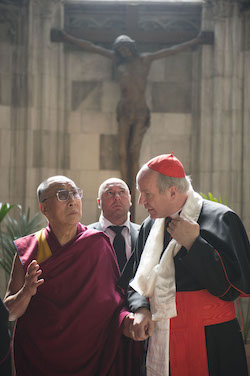
His Holiness the Dalai Lama in Vienna, 25-27 May 2012
© Manuel Bauer
One inevitable, and uncomfortable, thing that happens whenever the Buddhist and the Christian faith traditions are brought together in dialogue is that, if logic holds, only one party can be said to possess the truth. This is a stark and troubling fact. It is logically impossible for the foundational claims of both Buddhism and Christianity to be true. Christianity claims that the world was created out of nothing – ex nihilo. Buddhism claims that the world (or rather, samsara) has always existed.
Doubtless there are some people who would claim that this is incorrect, that logic does not apply here and that the world could, in some sense, be said to be God’s creation but in another sense also be uncreated since God Himself, as Creator, was not created. But the Dalai Lama is not one of them. For him, the principles of logic as elaborated within the Indo-Buddhist tradition (and which, to all intents and purposes are identical to the principles of Aristotelian syllogistic logic) are central to philosophical discourse. Indeed, the monastic debating courtyard is the very crucible of logical precision within the Tibetan tradition. When logic is abandoned, all sense is abandoned – even if it is also true that, instinctively, Buddhist thinkers try to avoid framing discussions in strictly either / or terms.
One might be forgiven for thinking that the question of whether the world had a beginning or not is trivial when it comes to the matter of how we conduct ourselves within the world – for example whether we do so with compassion or not. But, again, the Dalai Lama is not one of them. For him, the very thing that underpins compassion is this insight into the uncreated nature of the world and the illusion-like nature of selfhood.¹⁶ For him, it is insight of ‘how things really are’ that provides both the motive and the impetus for the individual’s exercise of compassion. When we truly appreciate the centrality of suffering – our own and others’ – we gain the inspiration to do something about it – above all by means of meditation whereby we start to ‘disarm’ the mind.
Here, though, we need to appreciate that when Christians speak of ‘the world’ and when the Dalai Lama speaks of ‘the world’, two quite different states of affairs are being spoken of. From the perspective of the Abrahamic traditions, the world is, first and foremost, a place whereas, for Buddhists, the world is, first and foremost, a state of being. This state of being is samsara, or cyclic existence, the always unsatisfactory state in which each sentient being remains and suffers and into which it is reborn time and time again until the moment that it attains Enlightenment / awakening. It has been argued that, to use Christian terminology, Buddhism sees Creation itself as the Fall.¹⁷ Yet to use such terminology risks obscuring the insight that underlies the Buddhist outlook on the ‘world’. What all sentient beings experience as a place is, rather, an illusion (or, better, is illusion-like) and arises out of a vast and complex set of causes and conditions, the ultimate nature of which is emptiness [Sanskrit sunya].
Indeed, it is this understanding of the ultimate – empty – nature of all that we perceive (including the one that perceives) that most sharply distinguishes Buddhist from Christian thought. From this distinction derive their two very different approaches to the predicament each individual finds themselves in. The Buddha, realising the truth of how things really are, out of compassion, articulated the Path which is the sole means of escaping the bonds of samsara.¹⁸ For His part, the Christ, out of compassion for humanity, submits willingly to death on the cross in atonement for the sins of all others. What is at issue for Christianity is thus not suffering, but sin.
There is, of course, much more that needs to be said about these different responses to the human predicament. The purpose of this paper is only to draw attention to some of them. But one way to evaluate the different claims made on behalf of the two traditions would be to ask how these different conceptualisations of the world – Creation and samsara – play out. Robert Thurman, one of the great popularisers of the Tibetan Buddhist tradition, has spoken of how pre-Communist Tibet was a ‘sacred space’ that comprised ‘one huge school for Enlightenment’¹⁹. This contrasts sharply with what historians tell us about traditional Tibetan society where most of the political power and most of the wealth lay in the hands of an alliance between the monasteries and a land-owning aristocracy. This power was expressed in the literal ownership of families who were obligated to serve their masters on pain of punishment up to, and sometimes including, death in retribution for disobedience. Within this system of obligation, not only was labour owed from one generation to the next (the only escape being entry to a monastery or, more rarely, to a higher class through marriage) but so, too, was debt. In the event that taxes owed to the monastic or aristocratic landlord could not be paid, the liability was postponed and could even be inherited. Indeed, if one were to assess traditional Tibetan society in terms of the current United Nations definition of slavery, one would be forced to conclude that servitude was a fact of life for a majority of the settled (ie non-nomadic) population.
Yet we should be wary of imposing the received ideas of one culture onto another, especially where what is being judged obtained in the past. If it were true that Tibetans resented their condition, one would expect to find they greeted their liberation from what the Communists described as ‘serfdom’ with open arms. Such was not the case. To the contrary, it was this very ‘liberation’ that fuelled Tibetan antagonism to China and led to armed resistance against the Chinese. There is little evidence to support the suggestion that even a substantial minority of Tibetans had any desire to overthrow what, as it seemed to most, was the right and proper way for society to be organised – even if it is true that justice was often summary (although prohibited by the Great Thirteenth Dalai Lama, mutilation of limbs was a not wholly uncommon punishment for petty criminals) and grudges all too often resulted in bloodshed (the Dalai Lama’s own father was very possibly assassinated by his personal enemies while the Regent who ruled Tibet during the Dalai Lama’s minority was certainly poisoned) while blood feuds between families were handed down through generations. Nor should it be forgotten that Tibet came to be considered by the Roman church to provide its most dangerous mission field.²⁰ Missionaries were regularly martyred there – the most recent being Blessed Maurice Tournay in 1949.
The picture of Tibetan society that emerges from the history books is one that is highly reminiscent of the European Middle Ages, though with some crucial differences. European feudalism did not generally permit hereditary debt, for example, while mutilation was practically unheard of (though there certainly were the rack and other torments). But in other respects the tenor of life in Europe during the Middle Ages was no less, and possibly even more violent than life during the high-point of Buddhist culture in Tibet (roughly from the mid-seventeenth to the mid-twentieth centuries). Moreover, from the Tibetan perspective, notwithstanding its many injustices, life in Tibet was certainly far more peaceful than it is in the modern world with its mechanised destruction of animals, its use of arms and armaments to kill indiscriminately and its industrialised slaughter of the unborn.
The question of how their different approaches to metaphysical questions plays out in the world is seen not so much in the way Christian and Buddhist societies organised themselves but in their attitude towards being in the world, however. Buddhism sees the oneness of all sentient beings (the six realms thereof comprising the heavenly realm, the realm of demigods, the human realm, the animal realm, the realm of ‘hungry ghosts’ and the hell realm) within samsara whereas Christianity thinks in terms of a Creation over which mankind rules, God having made human beings but ‘a little lower than the angels’.²¹
For the Buddhist, the world is not an object, or a collection of objects, to be manipulated and ordered according to the dictates of human determination. That explains why there is no industry nor, for example, any hospitals to be found in Buddhist countries before they encounter them through interaction with non-Buddhist cultures (though, to be sure, the Tibetan tradition may justly claim its own science – that of a science of mind construed in terms of Buddhist thought and it also has a complex and highly developed pre-modern medical system).
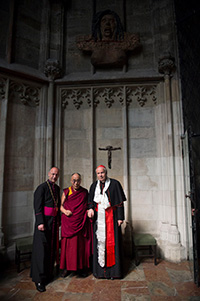
His Holiness the Dalai Lama in Vienna, 25-27 May 2012
© Manuel Bauer
So while this lack in interest in the manipulation of nature to further human interests might seem a shortcoming of the tradition, again we need to recognise that, on its own terms, the Tibetan attitude to the world is entirely consonant with its understanding that sentient beings’ involvement with the world is precisely one of the things that prevents liberation from it – or, rather, from samsara. This is true of any enterprise which has as its goal anything other than that training of the mind which is the necessary condition of liberation. It is hardly surprizing, therefore, that classical Tibet had neither a unified system of health care or, for that matter, any industry to speak of. Such activities offer, at best, superficial remedies to the fact of suffering and it is only compassion, correctly understood (as training the mind for the benefit of all others) and correctly directed (towards overcoming ignorance and the afflictive emotions), that is capable of conferring true and lasting benefit.
Given its claim that human beings are capable of bringing about their own salvation through training of the mind, it is sometimes argued that Buddhism presents a more optimistic view of humanity than does Christianity. Human beings are uniquely placed, from a Buddhist perspective. It is only they who can attain Enlightenment in this lifetime. And the individual’s progression towards liberation is a matter of his or her own deeds and not, as the Dalai Lama is at pains to say, simply a matter of ‘Buddha’s blessing’. We are therefore not speaking of redemption (there is neither self nor soul to redeem) but rather of patient, focussed effort over many lifetimes during which the individual mind-stream is gradually purified of ignorance and attachment.
Christianity insists, on the other hand, that there is only one life after which the soul enters either heaven or hell. There are no second chances after judgement. According to the teachings of the Roman church, humankind is, moreover, tainted with Original Sin. As a result, it is impossible for the individual to attain salvation except by the grace of God: we cannot get to heaven by ourselves and without the help of the Church, the sacraments and other instantiations of God’s generosity – the ultimate expression of which is Christ’s self-giving on the cross whereby Christ becomes, in turn, the means of our salvation and our final end in co-existence, in our resurrected bodies, with God in heaven. Yet it is also made clear that even the simplest, least educated of people may attain salvation – alongside even those most helplessly given over to sin – provided only that they repent of their sin and turn sincerely to God, through Christ (metanioa).
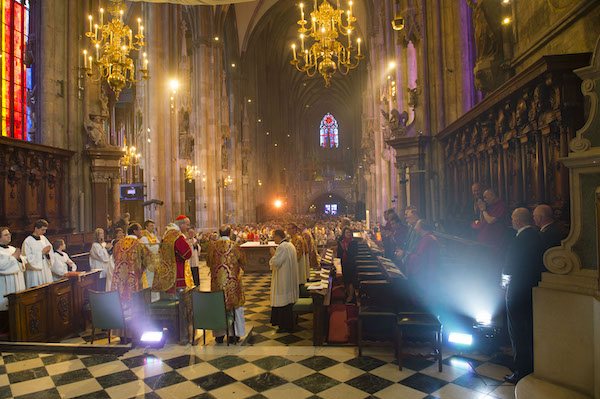
His Holiness the Dalai Lama in Vienna| 25-27 May 2012
© Manuel Bauer
So while Buddhism and Christianity both look on the self as the source of trouble, we find, in the end, that we are faced with two radically inconsistent responses to the fact of our existence. Buddhism denies the goodness of the world, proposing that its enjoyments are illusory, and seeks instead to assist the individual to overcome their implication in samsara through the exercise of compassion construed in terms of training the mind for the benefit of all other sentient beings. Christianity affirms the goodness of the world and, while taking a pessimistic view of the individual’s ability to attain salvation, offers the possibility of redemption through Christ by means of his compassionate self-offering on the Cross, once, and for all.
Put this way, we see that, despite many outward similarities, we are faced with a stark and, perhaps, uncomfortable choice between two incompatible approaches to the fact of our existence with entirely different outcomes both during this life and the next. ■
Notes
¹ This is only right. The Tibetan tradition sees the Dalai Lama as the earthly manifestation of Chenresig, the Bodhisattva of compassion.
² cf Psalm 24: 6; 85:15;102.4; 102:13 Matt 9:36; 14:14; 15:32; 18:33
³ Summa Theologica [hereafter STh] l 21.3 and l 25.3
⁴ TSTh ll 30 and ll 32
⁵ STh l-ll 24.4
⁶ Strictly, it is not accurate to speak of ‘Tibetan Buddhism’. It would be more correct, if clumsier, to speak of the Buddhist tradition of Tibet.
⁷ See Norman, Alexander Secret Lives of the Dalai Lama London, Little Brown 2008, p30 and note 3.
⁸ It is at just this time that the first diffusion of Buddhism in Tibet was getting under way.
⁹ It is true, however, that the Dalai Lama has an important role in the appointment of the abbots of the three principal dgelugs monasteries and in that of the Ganden Tripa, the titular head of the dgelugs school.
¹⁰ Note that the word lama in Tibetan tranlsates the Sanskrit term guru which denotes a spiritual guide or, more simply, a teacher.
¹¹ Mark 1:15
¹² Some scholars argue against the use of the term Enlightenment and prefer to retain the Sanskrit term bodhi which connotes awakening. Awakening to what? Awakening to the truth of the way things really are.
¹³ The Buddha himself appointed a Fourfold Assembly, a community of lay and ordained men and women, the successors of which later developed into the monastic communities we still see today.
¹⁴ cf Matthew 25. The church teaches seven works of corporal mercy: to feed the hungry, to give drink to the thirsty, to shelter the homeless, to comfort the sick, to visit prisoners, to bury the dead, to give alms to the poor.
¹⁵ From Shantideva’s [fl 8th century CE] famous prayer.
¹⁶ Note, however, that, on the Buddhist view, ‘uncreated’ does not mean uncaused. For Buddhists generally, samsara exists on account of the accumulated karma of countless sentient beings over time. It is not brought into being in the Christian sense of ex nihilo ‘something out of nothing’ by a Creator God.
¹⁷ By the French philosopher, Claude Tresmontant.
¹⁸ It is important to recognise that the term ‘realise’ is a loaded one in a Buddhist context: it denotes not mere intellectual assent but includes an experiential component in that the one who apprehends, for example, emptiness may, with determination and long effort, actually come, in some mystical sense, actually to experience emptiness.
¹⁹ Thurman, Robert Inner Revolution pp31-6, 39 and 247 London, Riverhead books 1998.
²⁰ Until it became clear that the Catholic missionaries were intent on converting the people to Christianity, they were actually well received. The Italian Jesuit Ipolito Desideri (1684-1733) was permitted to live within Drepung monastery even as he compiled several treatises designed to undermine the arguments of Tosngkhapa and his confreres. See the important article by Isrun Engelhard, “Between Tolerance and Dogmatism: Tibetan Reactions to the Capuchin Missionaries in Lhasa, 1707-1745.” Zentralasiatische Studien 34, pp. 55-97.
²¹ Psalm 8

ALEXANDER NORMAN holds a BA in Philosophy and Theology and an MSt in Oriental Studies from the University of Oxford.
He is a long-time associate of HH the Dalai Lama, having worked closely with the Tibetan leader on his autobiography, Freedom In Exile (London 1990, Hodder and Stoughton); Ethics For The New Millennium (London 2000, Little Brown) and Beyond Religion: Ethics For a Whole World (Boston 2011, Houghton Mifflin Harcourt). In addition, he has served as a speech writer for HH the Dalai Lama and on the Tibetan leader’s Special Review Committee. He is the author of Holder Of The White Lotus, a history of the Dalai Lama institution, and of an acclaimed biography of the Dalai Lama, The Dalai Lama: An Extraordinary Life (Boston 2020, Houghton Mifflin Harcourt).
He is President of the London-based charity, Help Tibet and he is Director of The Dalai Lama Centre for Compassion, Oxford, UK.
Header image: © Elke Hessel
See also
- Killing Langdarma: Compassionate Killing or Conflict Resolution? by Jens Schlieter
- The Dalai Lama from a Catholic perspective by Alexander Norman
- Imagining Tibet: Between Shangri-la and Feudal Oppression – Attempting a Synthesis by Thierry Dodin and Heinz Räther
- Human Rights in Tibet before 1959 by Robert Barnett
- Tibet as “Hell on Earth” by Elliot Sperling


